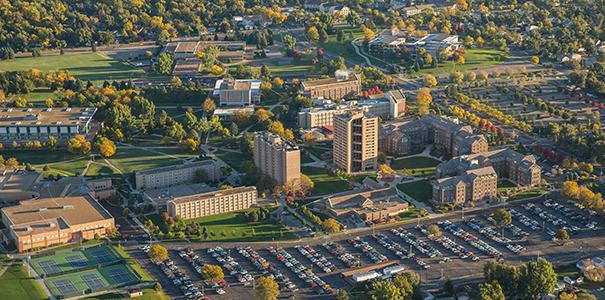
Article
November 15, 2021
Written by Deanna Herbert
UNC Moving Forward with Next Steps in Pursuit of Osteopathic Medical School
The University of Northern Colorado (UNC) is moving forward with their exploration of creating an osteopathic medical school in Greeley, a not-for-profit enterprise within the university.
The University of Northern Colorado (UNC) is moving forward with their exploration of creating an osteopathic medical school in Greeley, a not-for-profit enterprise within the university.
The decision to proceed comes after months of research and conversations with key stakeholders and based on the findings and recommendations from a feasibility study that UNC President Andy Feinstein recently presented to the university community and the Board of Trustees. In light of the study’s clear recommendation that UNC should continue pursuing development of an osteopathic medical school, and the overwhelmingly supportive feedback from UNC’s community, stakeholders and healthcare systems, the trustees approved the university’s next steps of applying for applicant status with the Commission on Osteopathic College Accreditation (COCA) and initiating the hiring process for a founding dean during their Nov. 12 meeting. Although the process will commence in the near term, a final hire for a founding dean will be conditioned on the university receiving statutory authorization from the State of Colorado to proceed with the project. While these are essential steps in the process, Feinstein cautioned that there’s a lot of work to be done before the project becomes a reality.
“Our university was founded 132 years ago in response to the need for teachers in communities across Colorado. Today, we find ourselves positioned to meet another critical challenge that will shape the health, strength and growth potential of Greeley, Weld County and the state for many years to come,” Feinstein said. “To be clear, there are still a number of gates that we will need to pass in order for this to come to fruition. However, my optimism and excitement about the possibility of UNC creating a new medical school to meet the needs of our community continue to grow.”
The critical challenge Feinstein is readying his university to meet is the fact that Colorado’s current medical education infrastructure does not produce enough physicians to meet current and future needs, nor does it meet the demand for students who want to pursue medical education. The state’s booming population growth over the last decade coupled with Colorado’s high percentage of active physicians aged 60 or older who are expected to exit the workforce in the next few years, are both driving factors creating a shortage of physicians in the state. According to the Health Resources and Services Administration (HRSA), only 34.6% of the state’s need for physicians is met. Additionally, the Association of American Medical Colleges predicts a shortage of up to 139,000 physicians across the U.S. by 2033. These and a number of other findings were compiled in the donor-funded feasibility study launched last July by the consulting firm Tripp Umbach, a leader in medical education consulting.
The study included an evaluation of market demand, economic impact and the capacity and commitment of healthcare providers to support clinical placements. It highlighted the increasing popularity and viability of osteopathic medicine and the school’s potential to be a driver of the regional economy, creating jobs and generating significant economic and social impacts to the state of Colorado. Other key findings included:
- The Robert Graham Center forecasts that by 2030, Colorado will need an additional 1,773 primary care physicians (PCP)s, a 49% increase compared to the state’s 2010 primary care physician workforce.
- Colorado needs more doctors, specifically in rural areas. The osteopathic medical profession has a long tradition of providing care where patients lack doctors. One of the most effective strategies to recruit and retain physicians in rural areas is to create new medical education training sites in or near these locations. More than 60% of students at peer rural D.O. programs are from their home state and remain in the state to practice after graduation.
- This past year, the number of osteopathic physicians in the U.S. rose to nearly 135,000, an 80% increase over the past decade. Both allopathic (M.D.) and osteopathic (D.O.) medical schools teach students the scientific foundations needed to become licensed physicians, but they take different approaches. Allopathic medicine focuses on diagnosing and treating medical conditions, while osteopathic medicine takes a more holistic, patient-centered approach and focuses heavily on prevention.
- The development of an osteopathic medical school would have a positive impact on other health science programs at UNC, including the university’s programs in nursing, audiology, public health, biomedical sciences, health sciences and behavioral sciences. Developing synergies among osteopathic medicine and these existing programs, as well as strategically investing in their expansion whenever possible, will create new opportunities for students and expand the university’s capacity to directly influence the health and strength of communities across Colorado.
As the university moves forward with the accreditation process and hiring the founding dean, there are other items UNC must address, not the least of which is securing approximately $135 million in funding over the next several years. That estimate addresses the cost of new facilities, expenses associated with pursuing accreditation and the hiring of faculty and staff and an escrow account required to meet accreditation obligations. The start-up funding to support the project will primarily come from external sources, including philanthropic support. Once the medical school has been established, it is expected to generate enough revenue to be self-supporting.
One important hurdle the university has already cleared is securing the majority of the clinical rotation sites required for third- and fourth-year students, thanks to a partnership with Banner Medical Group and Banner Health’s northern Colorado hospitals.
“The development of an osteopathic medical school at UNC will develop a much-needed pipeline of physicians to support the region’s growing population,” said Brian Davidson, MD, Banner Medical Group Western Region physician executive. “Banner is excited about its role in providing a substantial number of core clinical rotations for third- and fourth-year medical students and giving our current team members that chance to help cultivate the next generation of physicians,” Dr. Davidson said.
Margo Karsten, Banner Health Western Region president, was an early participant and supporter of discussions about the school. “The project has been a true collaboration across several public and private sectors. It will benefit the economy and add to the quality of life in Greeley and Weld County.”
UNC is also working with other healthcare providers to secure additional placements.
With the support of the community, stakeholders and trustees behind it, the university is optimistic that as the necessary pieces fall into place from this point through to completion, UNC could see its first class of students in the fall of 2025.
Links to the feasibility study, UNC’s town hall presentation, FAQs and regular progress updates will be provided on UNC’s osteopathic medical school exploration webpage.



